Criminology and Justice: History, Establishment & Impact of UK Police
VerifiedAdded on 2023/06/15
|7
|1472
|78
Essay
AI Summary
This essay explores the history of policing in the UK, beginning with the voluntary practices of constables and citizens and culminating in the establishment of the Metropolitan Police Service by Sir Robert Peel in 1829. It discusses Peel's principles of policing, emphasizing crime prevention and the importance of public legitimacy. The essay also examines the impact of police establishment in the modern era, including the challenges faced by contemporary police forces, government interference, and legislative reforms aimed at ensuring accountability and transparency. It highlights the multiple roles of modern police, including securing social order, dealing with conflicting arenas, and maintaining peace, and concludes that despite changes in police law and management, the core objective of preventing crime and safeguarding society remains central to UK policing.
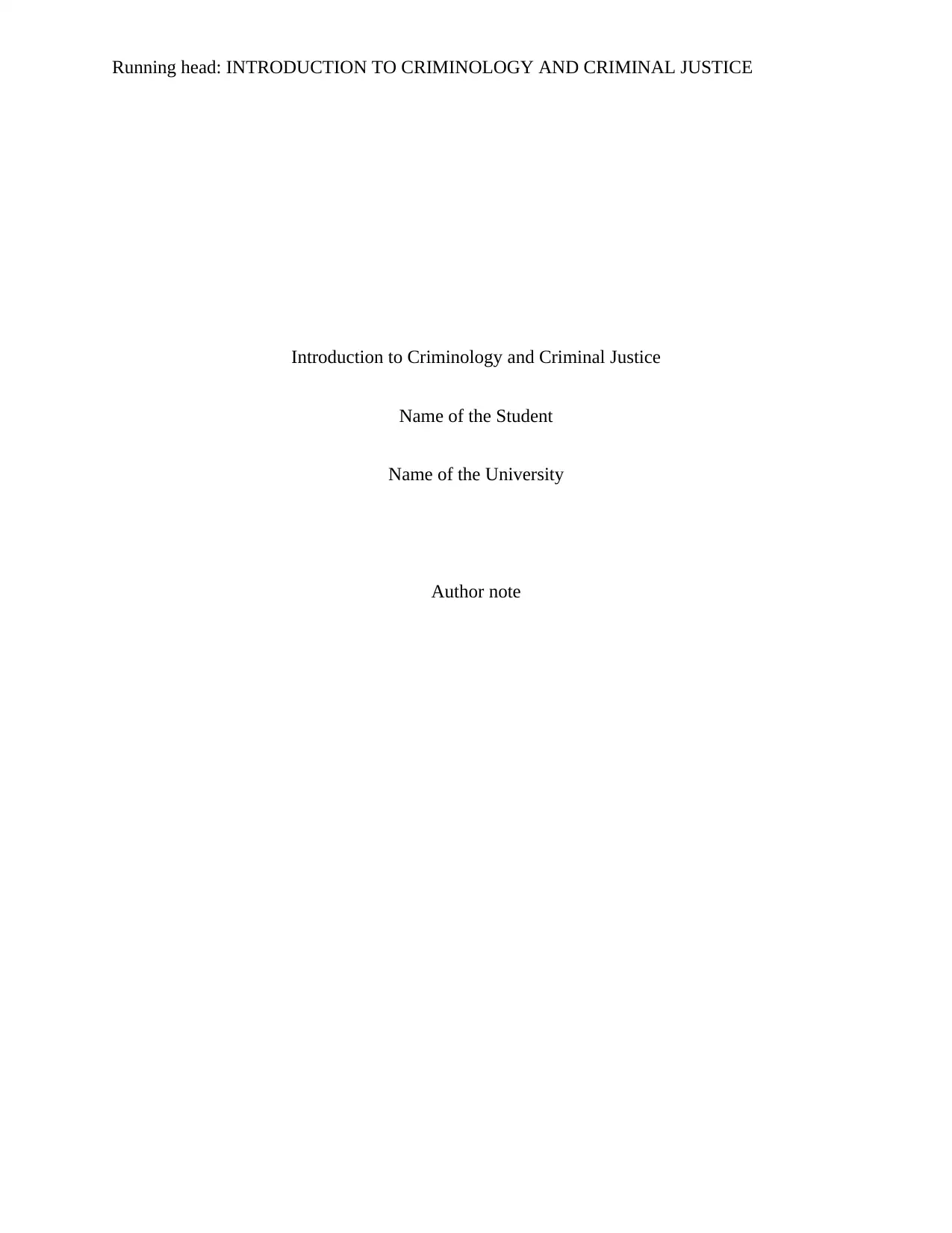
Running head: INTRODUCTION TO CRIMINOLOGY AND CRIMINAL JUSTICE
Introduction to Criminology and Criminal Justice
Name of the Student
Name of the University
Author note
Introduction to Criminology and Criminal Justice
Name of the Student
Name of the University
Author note
Paraphrase This Document
Need a fresh take? Get an instant paraphrase of this document with our AI Paraphraser
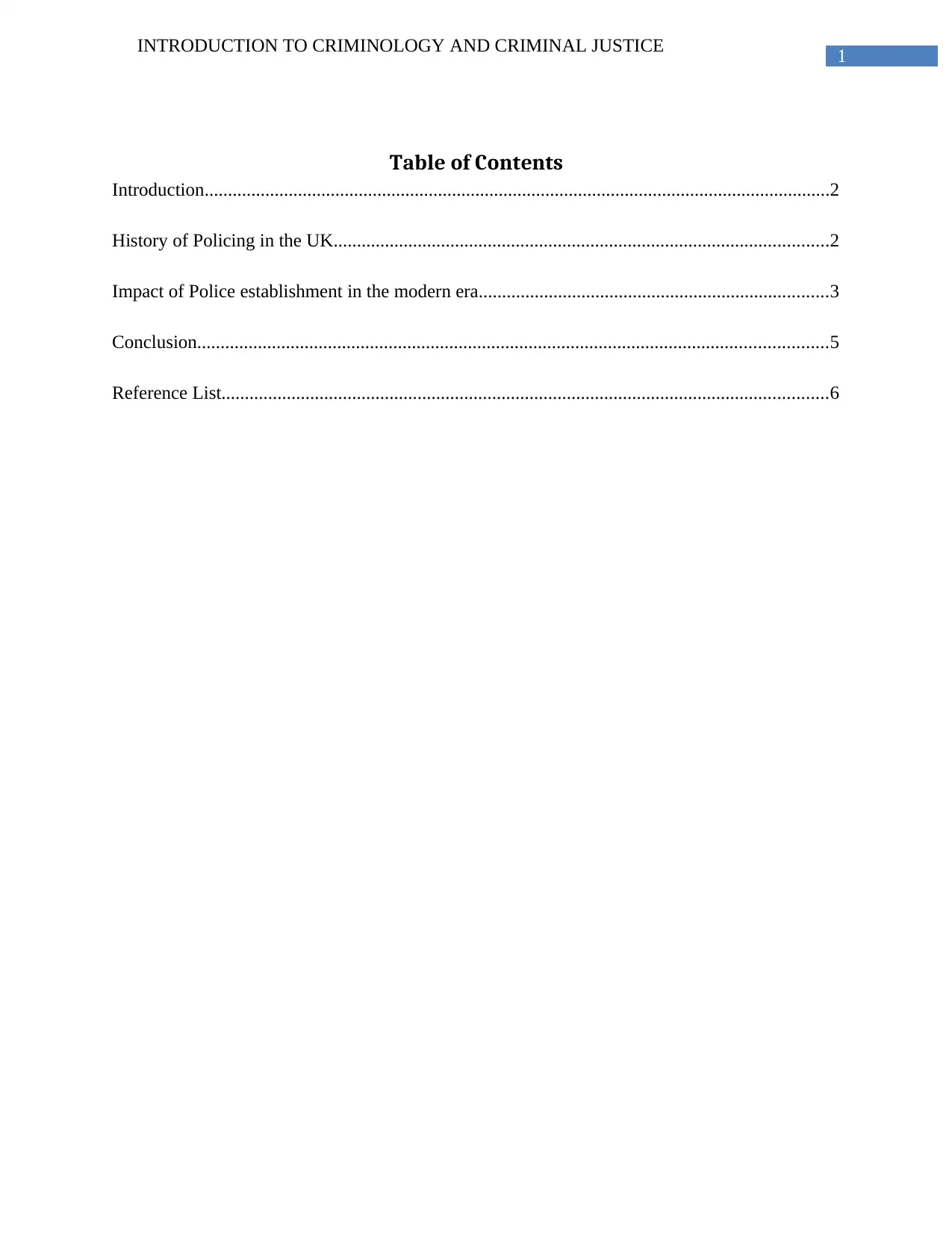
1
INTRODUCTION TO CRIMINOLOGY AND CRIMINAL JUSTICE
Table of Contents
Introduction......................................................................................................................................2
History of Policing in the UK..........................................................................................................2
Impact of Police establishment in the modern era...........................................................................3
Conclusion.......................................................................................................................................5
Reference List..................................................................................................................................6
INTRODUCTION TO CRIMINOLOGY AND CRIMINAL JUSTICE
Table of Contents
Introduction......................................................................................................................................2
History of Policing in the UK..........................................................................................................2
Impact of Police establishment in the modern era...........................................................................3
Conclusion.......................................................................................................................................5
Reference List..................................................................................................................................6
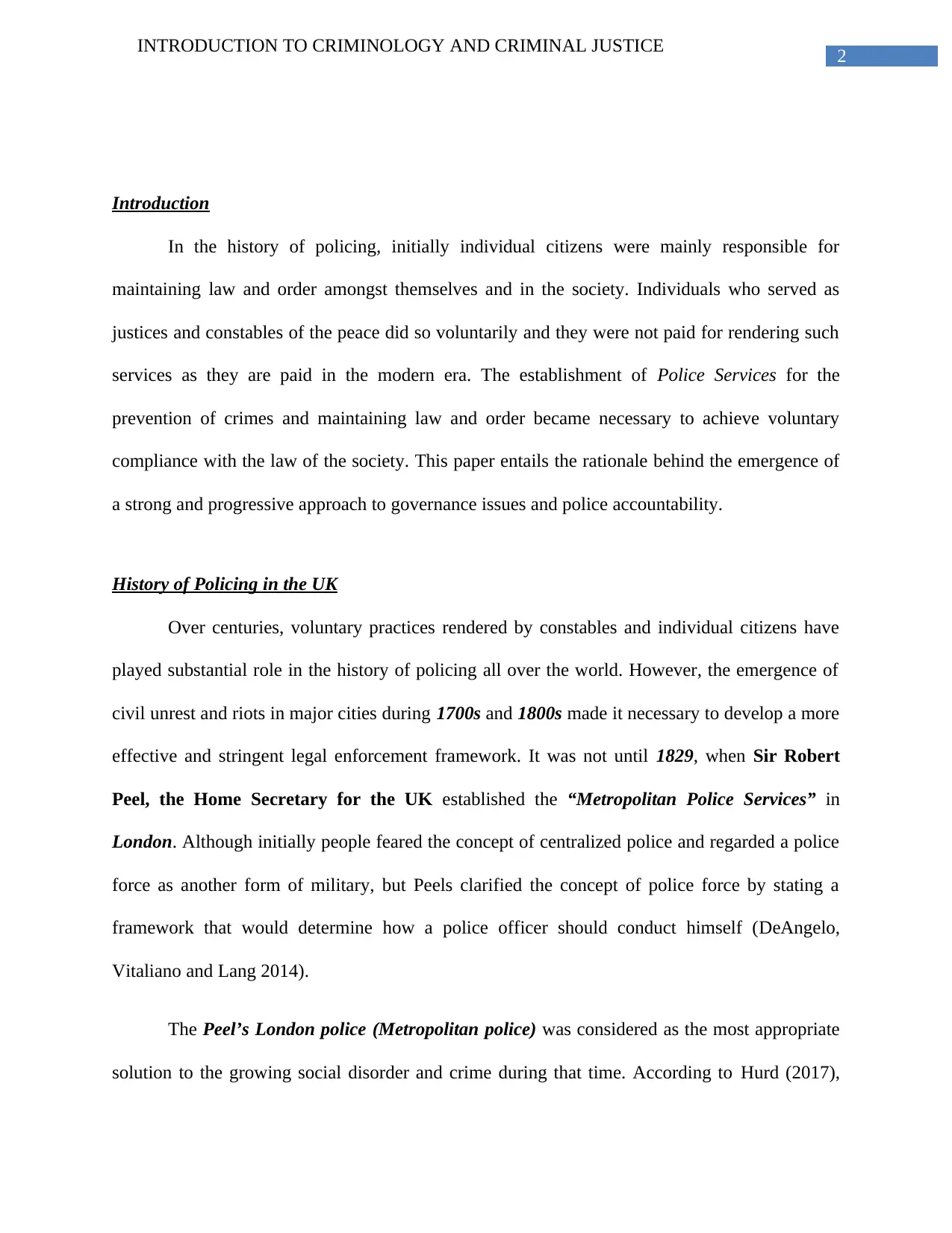
2
INTRODUCTION TO CRIMINOLOGY AND CRIMINAL JUSTICE
Introduction
In the history of policing, initially individual citizens were mainly responsible for
maintaining law and order amongst themselves and in the society. Individuals who served as
justices and constables of the peace did so voluntarily and they were not paid for rendering such
services as they are paid in the modern era. The establishment of Police Services for the
prevention of crimes and maintaining law and order became necessary to achieve voluntary
compliance with the law of the society. This paper entails the rationale behind the emergence of
a strong and progressive approach to governance issues and police accountability.
History of Policing in the UK
Over centuries, voluntary practices rendered by constables and individual citizens have
played substantial role in the history of policing all over the world. However, the emergence of
civil unrest and riots in major cities during 1700s and 1800s made it necessary to develop a more
effective and stringent legal enforcement framework. It was not until 1829, when Sir Robert
Peel, the Home Secretary for the UK established the “Metropolitan Police Services” in
London. Although initially people feared the concept of centralized police and regarded a police
force as another form of military, but Peels clarified the concept of police force by stating a
framework that would determine how a police officer should conduct himself (DeAngelo,
Vitaliano and Lang 2014).
The Peel’s London police (Metropolitan police) was considered as the most appropriate
solution to the growing social disorder and crime during that time. According to Hurd (2017),
INTRODUCTION TO CRIMINOLOGY AND CRIMINAL JUSTICE
Introduction
In the history of policing, initially individual citizens were mainly responsible for
maintaining law and order amongst themselves and in the society. Individuals who served as
justices and constables of the peace did so voluntarily and they were not paid for rendering such
services as they are paid in the modern era. The establishment of Police Services for the
prevention of crimes and maintaining law and order became necessary to achieve voluntary
compliance with the law of the society. This paper entails the rationale behind the emergence of
a strong and progressive approach to governance issues and police accountability.
History of Policing in the UK
Over centuries, voluntary practices rendered by constables and individual citizens have
played substantial role in the history of policing all over the world. However, the emergence of
civil unrest and riots in major cities during 1700s and 1800s made it necessary to develop a more
effective and stringent legal enforcement framework. It was not until 1829, when Sir Robert
Peel, the Home Secretary for the UK established the “Metropolitan Police Services” in
London. Although initially people feared the concept of centralized police and regarded a police
force as another form of military, but Peels clarified the concept of police force by stating a
framework that would determine how a police officer should conduct himself (DeAngelo,
Vitaliano and Lang 2014).
The Peel’s London police (Metropolitan police) was considered as the most appropriate
solution to the growing social disorder and crime during that time. According to Hurd (2017),
⊘ This is a preview!⊘
Do you want full access?
Subscribe today to unlock all pages.

Trusted by 1+ million students worldwide
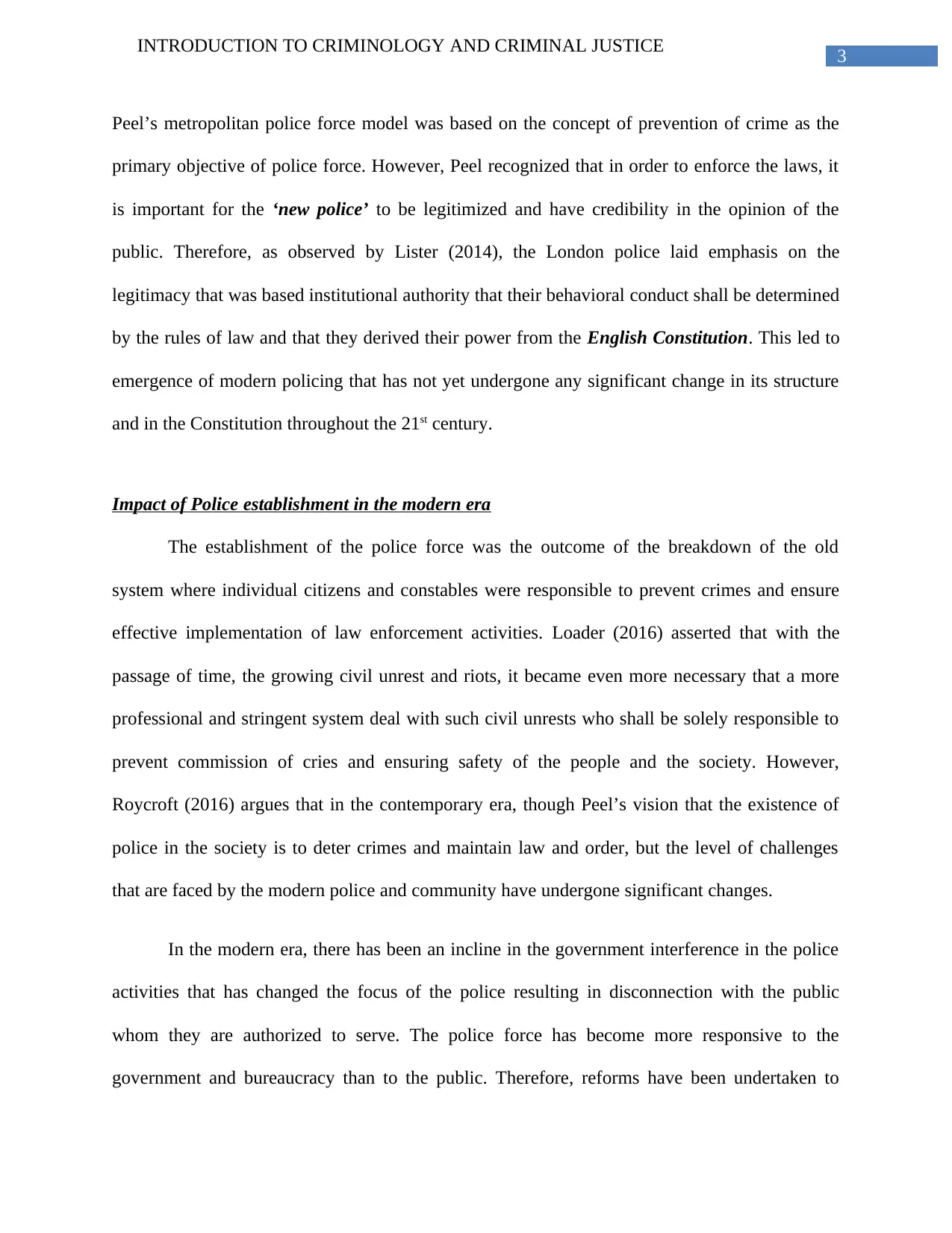
3
INTRODUCTION TO CRIMINOLOGY AND CRIMINAL JUSTICE
Peel’s metropolitan police force model was based on the concept of prevention of crime as the
primary objective of police force. However, Peel recognized that in order to enforce the laws, it
is important for the ‘new police’ to be legitimized and have credibility in the opinion of the
public. Therefore, as observed by Lister (2014), the London police laid emphasis on the
legitimacy that was based institutional authority that their behavioral conduct shall be determined
by the rules of law and that they derived their power from the English Constitution. This led to
emergence of modern policing that has not yet undergone any significant change in its structure
and in the Constitution throughout the 21st century.
Impact of Police establishment in the modern era
The establishment of the police force was the outcome of the breakdown of the old
system where individual citizens and constables were responsible to prevent crimes and ensure
effective implementation of law enforcement activities. Loader (2016) asserted that with the
passage of time, the growing civil unrest and riots, it became even more necessary that a more
professional and stringent system deal with such civil unrests who shall be solely responsible to
prevent commission of cries and ensuring safety of the people and the society. However,
Roycroft (2016) argues that in the contemporary era, though Peel’s vision that the existence of
police in the society is to deter crimes and maintain law and order, but the level of challenges
that are faced by the modern police and community have undergone significant changes.
In the modern era, there has been an incline in the government interference in the police
activities that has changed the focus of the police resulting in disconnection with the public
whom they are authorized to serve. The police force has become more responsive to the
government and bureaucracy than to the public. Therefore, reforms have been undertaken to
INTRODUCTION TO CRIMINOLOGY AND CRIMINAL JUSTICE
Peel’s metropolitan police force model was based on the concept of prevention of crime as the
primary objective of police force. However, Peel recognized that in order to enforce the laws, it
is important for the ‘new police’ to be legitimized and have credibility in the opinion of the
public. Therefore, as observed by Lister (2014), the London police laid emphasis on the
legitimacy that was based institutional authority that their behavioral conduct shall be determined
by the rules of law and that they derived their power from the English Constitution. This led to
emergence of modern policing that has not yet undergone any significant change in its structure
and in the Constitution throughout the 21st century.
Impact of Police establishment in the modern era
The establishment of the police force was the outcome of the breakdown of the old
system where individual citizens and constables were responsible to prevent crimes and ensure
effective implementation of law enforcement activities. Loader (2016) asserted that with the
passage of time, the growing civil unrest and riots, it became even more necessary that a more
professional and stringent system deal with such civil unrests who shall be solely responsible to
prevent commission of cries and ensuring safety of the people and the society. However,
Roycroft (2016) argues that in the contemporary era, though Peel’s vision that the existence of
police in the society is to deter crimes and maintain law and order, but the level of challenges
that are faced by the modern police and community have undergone significant changes.
In the modern era, there has been an incline in the government interference in the police
activities that has changed the focus of the police resulting in disconnection with the public
whom they are authorized to serve. The police force has become more responsive to the
government and bureaucracy than to the public. Therefore, reforms have been undertaken to
Paraphrase This Document
Need a fresh take? Get an instant paraphrase of this document with our AI Paraphraser
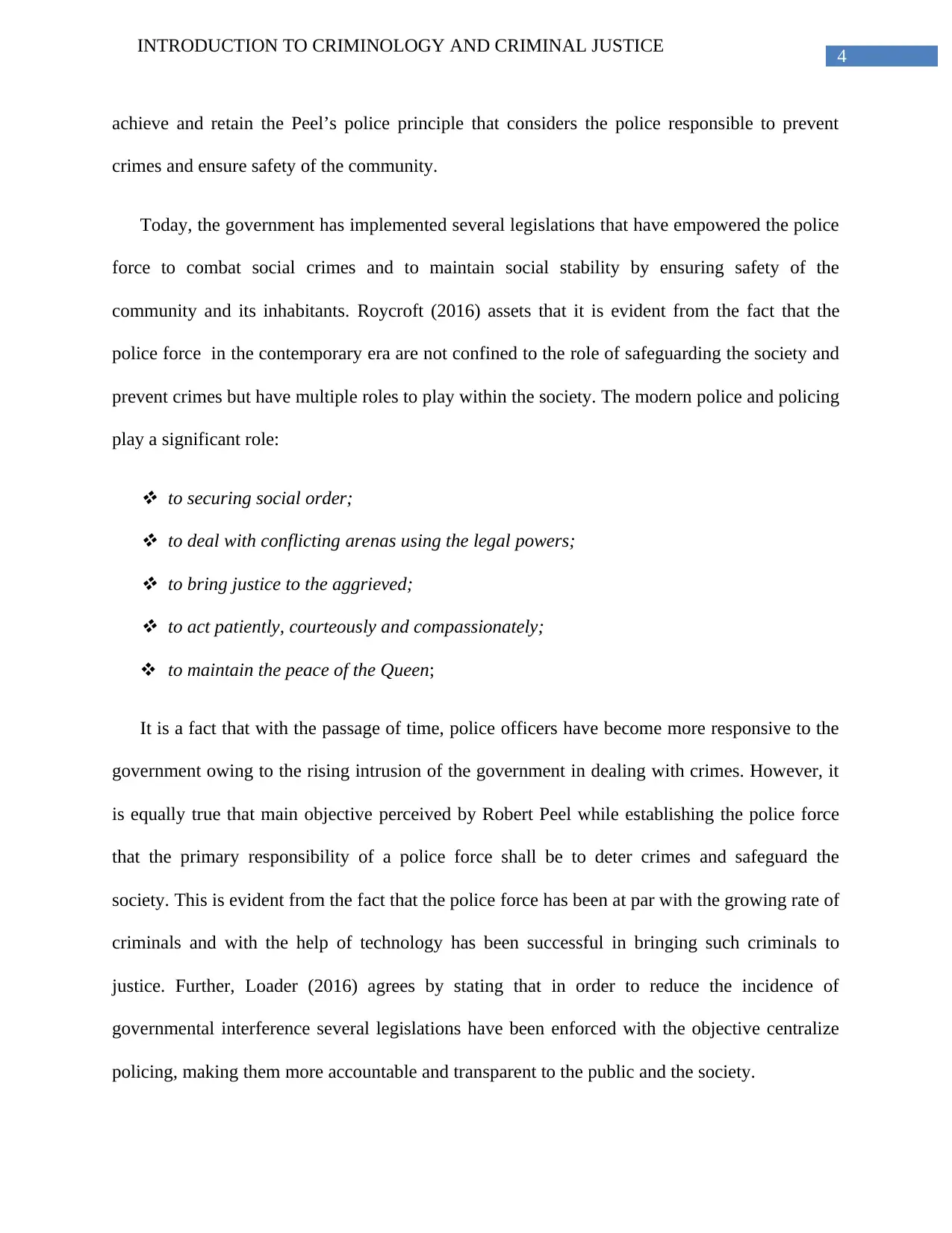
4
INTRODUCTION TO CRIMINOLOGY AND CRIMINAL JUSTICE
achieve and retain the Peel’s police principle that considers the police responsible to prevent
crimes and ensure safety of the community.
Today, the government has implemented several legislations that have empowered the police
force to combat social crimes and to maintain social stability by ensuring safety of the
community and its inhabitants. Roycroft (2016) assets that it is evident from the fact that the
police force in the contemporary era are not confined to the role of safeguarding the society and
prevent crimes but have multiple roles to play within the society. The modern police and policing
play a significant role:
to securing social order; to deal with conflicting arenas using the legal powers; to bring justice to the aggrieved; to act patiently, courteously and compassionately;
to maintain the peace of the Queen;
It is a fact that with the passage of time, police officers have become more responsive to the
government owing to the rising intrusion of the government in dealing with crimes. However, it
is equally true that main objective perceived by Robert Peel while establishing the police force
that the primary responsibility of a police force shall be to deter crimes and safeguard the
society. This is evident from the fact that the police force has been at par with the growing rate of
criminals and with the help of technology has been successful in bringing such criminals to
justice. Further, Loader (2016) agrees by stating that in order to reduce the incidence of
governmental interference several legislations have been enforced with the objective centralize
policing, making them more accountable and transparent to the public and the society.
INTRODUCTION TO CRIMINOLOGY AND CRIMINAL JUSTICE
achieve and retain the Peel’s police principle that considers the police responsible to prevent
crimes and ensure safety of the community.
Today, the government has implemented several legislations that have empowered the police
force to combat social crimes and to maintain social stability by ensuring safety of the
community and its inhabitants. Roycroft (2016) assets that it is evident from the fact that the
police force in the contemporary era are not confined to the role of safeguarding the society and
prevent crimes but have multiple roles to play within the society. The modern police and policing
play a significant role:
to securing social order; to deal with conflicting arenas using the legal powers; to bring justice to the aggrieved; to act patiently, courteously and compassionately;
to maintain the peace of the Queen;
It is a fact that with the passage of time, police officers have become more responsive to the
government owing to the rising intrusion of the government in dealing with crimes. However, it
is equally true that main objective perceived by Robert Peel while establishing the police force
that the primary responsibility of a police force shall be to deter crimes and safeguard the
society. This is evident from the fact that the police force has been at par with the growing rate of
criminals and with the help of technology has been successful in bringing such criminals to
justice. Further, Loader (2016) agrees by stating that in order to reduce the incidence of
governmental interference several legislations have been enforced with the objective centralize
policing, making them more accountable and transparent to the public and the society.
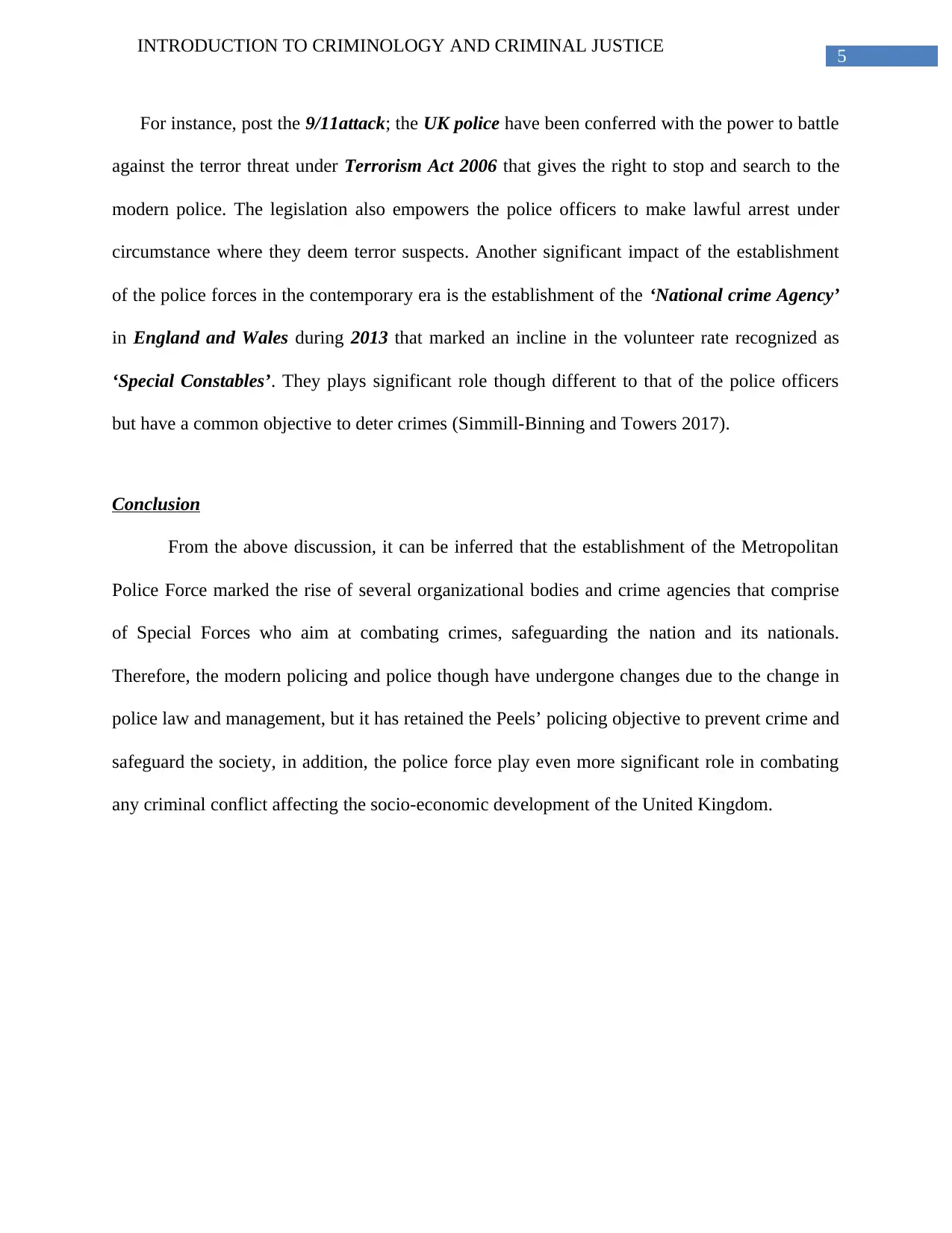
5
INTRODUCTION TO CRIMINOLOGY AND CRIMINAL JUSTICE
For instance, post the 9/11attack; the UK police have been conferred with the power to battle
against the terror threat under Terrorism Act 2006 that gives the right to stop and search to the
modern police. The legislation also empowers the police officers to make lawful arrest under
circumstance where they deem terror suspects. Another significant impact of the establishment
of the police forces in the contemporary era is the establishment of the ‘National crime Agency’
in England and Wales during 2013 that marked an incline in the volunteer rate recognized as
‘Special Constables’. They plays significant role though different to that of the police officers
but have a common objective to deter crimes (Simmill-Binning and Towers 2017).
Conclusion
From the above discussion, it can be inferred that the establishment of the Metropolitan
Police Force marked the rise of several organizational bodies and crime agencies that comprise
of Special Forces who aim at combating crimes, safeguarding the nation and its nationals.
Therefore, the modern policing and police though have undergone changes due to the change in
police law and management, but it has retained the Peels’ policing objective to prevent crime and
safeguard the society, in addition, the police force play even more significant role in combating
any criminal conflict affecting the socio-economic development of the United Kingdom.
INTRODUCTION TO CRIMINOLOGY AND CRIMINAL JUSTICE
For instance, post the 9/11attack; the UK police have been conferred with the power to battle
against the terror threat under Terrorism Act 2006 that gives the right to stop and search to the
modern police. The legislation also empowers the police officers to make lawful arrest under
circumstance where they deem terror suspects. Another significant impact of the establishment
of the police forces in the contemporary era is the establishment of the ‘National crime Agency’
in England and Wales during 2013 that marked an incline in the volunteer rate recognized as
‘Special Constables’. They plays significant role though different to that of the police officers
but have a common objective to deter crimes (Simmill-Binning and Towers 2017).
Conclusion
From the above discussion, it can be inferred that the establishment of the Metropolitan
Police Force marked the rise of several organizational bodies and crime agencies that comprise
of Special Forces who aim at combating crimes, safeguarding the nation and its nationals.
Therefore, the modern policing and police though have undergone changes due to the change in
police law and management, but it has retained the Peels’ policing objective to prevent crime and
safeguard the society, in addition, the police force play even more significant role in combating
any criminal conflict affecting the socio-economic development of the United Kingdom.
⊘ This is a preview!⊘
Do you want full access?
Subscribe today to unlock all pages.

Trusted by 1+ million students worldwide
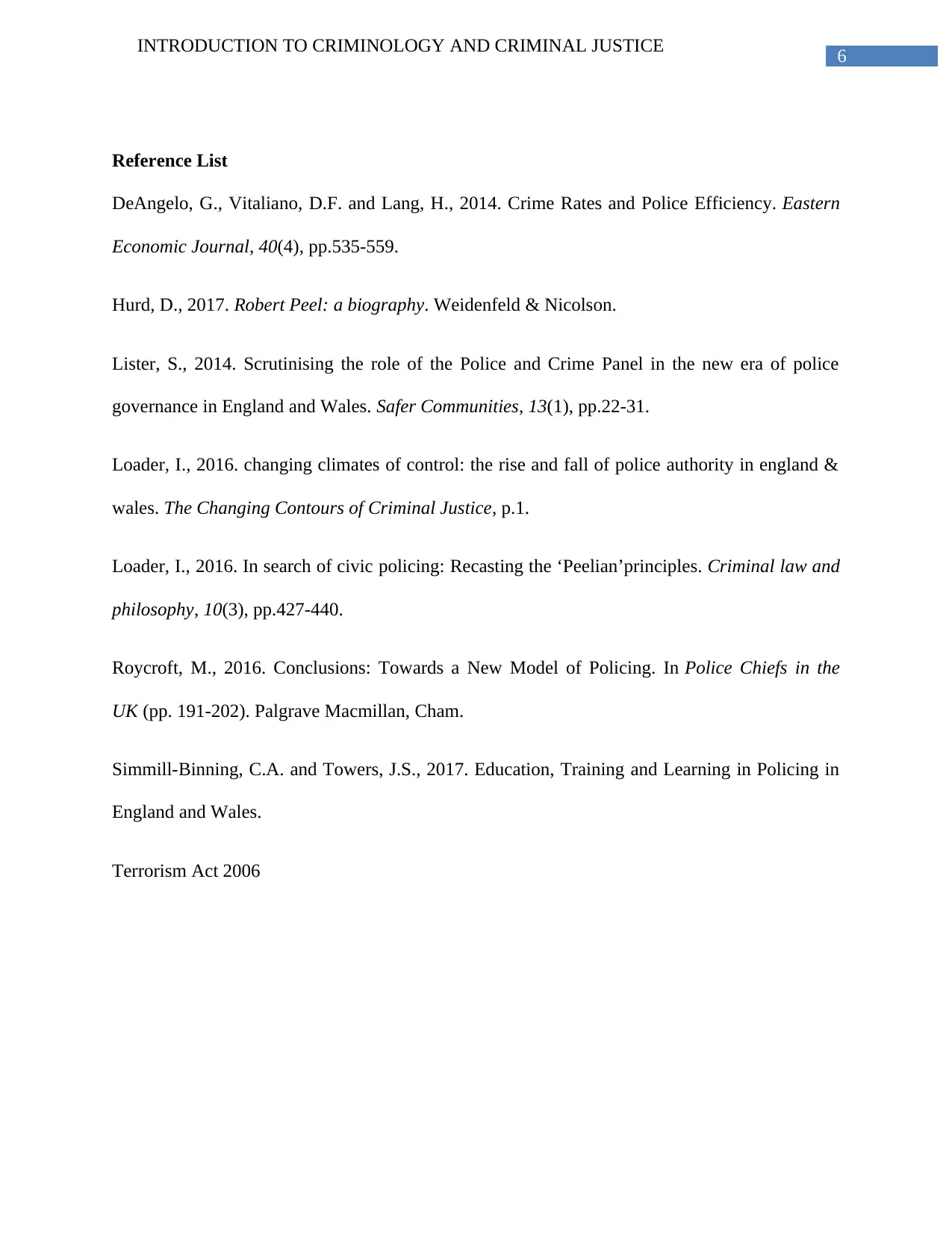
6
INTRODUCTION TO CRIMINOLOGY AND CRIMINAL JUSTICE
Reference List
DeAngelo, G., Vitaliano, D.F. and Lang, H., 2014. Crime Rates and Police Efficiency. Eastern
Economic Journal, 40(4), pp.535-559.
Hurd, D., 2017. Robert Peel: a biography. Weidenfeld & Nicolson.
Lister, S., 2014. Scrutinising the role of the Police and Crime Panel in the new era of police
governance in England and Wales. Safer Communities, 13(1), pp.22-31.
Loader, I., 2016. changing climates of control: the rise and fall of police authority in england &
wales. The Changing Contours of Criminal Justice, p.1.
Loader, I., 2016. In search of civic policing: Recasting the ‘Peelian’principles. Criminal law and
philosophy, 10(3), pp.427-440.
Roycroft, M., 2016. Conclusions: Towards a New Model of Policing. In Police Chiefs in the
UK (pp. 191-202). Palgrave Macmillan, Cham.
Simmill-Binning, C.A. and Towers, J.S., 2017. Education, Training and Learning in Policing in
England and Wales.
Terrorism Act 2006
INTRODUCTION TO CRIMINOLOGY AND CRIMINAL JUSTICE
Reference List
DeAngelo, G., Vitaliano, D.F. and Lang, H., 2014. Crime Rates and Police Efficiency. Eastern
Economic Journal, 40(4), pp.535-559.
Hurd, D., 2017. Robert Peel: a biography. Weidenfeld & Nicolson.
Lister, S., 2014. Scrutinising the role of the Police and Crime Panel in the new era of police
governance in England and Wales. Safer Communities, 13(1), pp.22-31.
Loader, I., 2016. changing climates of control: the rise and fall of police authority in england &
wales. The Changing Contours of Criminal Justice, p.1.
Loader, I., 2016. In search of civic policing: Recasting the ‘Peelian’principles. Criminal law and
philosophy, 10(3), pp.427-440.
Roycroft, M., 2016. Conclusions: Towards a New Model of Policing. In Police Chiefs in the
UK (pp. 191-202). Palgrave Macmillan, Cham.
Simmill-Binning, C.A. and Towers, J.S., 2017. Education, Training and Learning in Policing in
England and Wales.
Terrorism Act 2006
1 out of 7
Related Documents
Your All-in-One AI-Powered Toolkit for Academic Success.
+13062052269
info@desklib.com
Available 24*7 on WhatsApp / Email
![[object Object]](/_next/static/media/star-bottom.7253800d.svg)
Unlock your academic potential
Copyright © 2020–2025 A2Z Services. All Rights Reserved. Developed and managed by ZUCOL.





